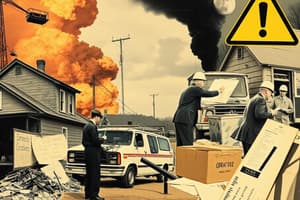Podcast
Questions and Answers
What can natural disasters lead to in terms of healthcare services?
What can natural disasters lead to in terms of healthcare services?
- A decrease in disease risk
- A gradual decrease in patient influx
- An increase in medical staff
- A sudden influx of patients, damage to medical facilities, and disruption of regular healthcare services (correct)
What was the impact of the 2010 earthquake in Haiti on the country's healthcare capacity?
What was the impact of the 2010 earthquake in Haiti on the country's healthcare capacity?
- It had no effect on the country's healthcare capacity
- It only affected rural areas
- It severely limited the country's healthcare capacity (correct)
- It increased the country's healthcare capacity
What is a potential health risk associated with hurricanes and floods?
What is a potential health risk associated with hurricanes and floods?
- Decreased risk of respiratory diseases
- Increased risk of cancer
- Increased risk of cardiovascular disease
- Increased risk of waterborne diseases (correct)
What is a mitigation strategy for natural disasters in healthcare?
What is a mitigation strategy for natural disasters in healthcare?
What type of disaster is a nuclear accident an example of?
What type of disaster is a nuclear accident an example of?
What was the impact of the 2004 Indian Ocean tsunami on the healthcare systems in the region?
What was the impact of the 2004 Indian Ocean tsunami on the healthcare systems in the region?
What is a potential health effect of wildfires?
What is a potential health effect of wildfires?
What is a potential long-term health effect of technological disasters?
What is a potential long-term health effect of technological disasters?
What is a common effect of nuclear accidents on human health?
What is a common effect of nuclear accidents on human health?
What was a significant consequence of the Deepwater Horizon oil spill in 2010?
What was a significant consequence of the Deepwater Horizon oil spill in 2010?
What is a crucial step in preventing man-made disasters?
What is a crucial step in preventing man-made disasters?
What was a key factor in the effective response to the Boston Marathon bombing in 2013?
What was a key factor in the effective response to the Boston Marathon bombing in 2013?
What is a characteristic of public health emergencies?
What is a characteristic of public health emergencies?
What was a significant challenge faced by healthcare systems during the COVID-19 pandemic?
What was a significant challenge faced by healthcare systems during the COVID-19 pandemic?
What is a crucial aspect of mitigation strategies for man-made disasters?
What is a crucial aspect of mitigation strategies for man-made disasters?
What was a significant effect of the Syrian conflict on healthcare?
What was a significant effect of the Syrian conflict on healthcare?
Flashcards are hidden until you start studying
Study Notes
Natural Disasters
- Natural disasters are events triggered by environmental factors that can cause severe harm to human life and infrastructure.
- Examples include earthquakes, hurricanes, floods, wildfires, and tsunamis.
- These disasters can lead to a sudden influx of patients, damage to medical facilities, disruption of regular healthcare services, and increased disease risk due to population displacement and contamination.
Earthquakes
- Can destroy hospital buildings and infrastructure, disrupt communication and transportation.
- The 2010 earthquake in Haiti collapsed hospitals and severely limited the country's healthcare capacity.
Hurricanes and Floods
- Can lead to power outages, water contamination, and an increase in waterborne diseases.
- Hurricane Katrina in 2005 severely affected the healthcare system of New Orleans, with many hospitals becoming inaccessible due to flooding.
Wildfires
- Can cause respiratory issues, burns, and stress-related health issues.
- The California wildfires in 2020 stretched the state's healthcare resources thin due to a surge in respiratory and burn-related conditions.
Case Studies
- The 2004 Indian Ocean tsunami significantly affected the healthcare systems in Indonesia, Thailand, and other countries in the region, requiring international assistance to cope.
Mitigation Strategies
- Building earthquake and flood-resistant healthcare facilities.
- Having an emergency evacuation plan.
- Ensuring redundant communication systems.
- Preparing the community through health education.
Technological Disasters
- Technological disasters refer to non-natural catastrophic events that result from human activity, including nuclear accidents, chemical spills, or oil spills.
- These events can cause immediate harm and long-term health effects.
- They require specialized treatment protocols and often create significant public fear and anxiety.
Nuclear Accidents
- The Chernobyl disaster in 1986 led to acute radiation sickness, increased cancer rates, and mental health issues.
Oil Spills
- The Deepwater Horizon oil spill in 2010 resulted in respiratory issues, skin irritation, and mental health problems among cleanup workers and affected communities.
Case Studies
- The Bhopal gas tragedy in 1984, one of the worst industrial accidents, released toxic gas into the city, killing thousands and leaving many with lifelong health issues.
Mitigation Strategies
- Regular safety checks and protocols can prevent such disasters.
- In case of an event, prompt containment, evacuation, and specialized medical treatments are critical.
Man-Made Disasters
- Man-made disasters involve intentional harm-causing activities like acts of terrorism or armed conflict.
- These events can cause immediate harm, long-term health effects, and significant public fear and anxiety.
Terrorism
- The 9/11 attacks resulted in immediate mass casualties, mental health issues, and long-term respiratory problems due to dust and debris inhalation.
Armed Conflict
- The ongoing Syrian conflict has destroyed healthcare facilities and hindered access to healthcare services, exacerbating population health problems.
Case Studies
- The Boston Marathon bombing in 2013 demonstrated effective disaster response, with rapid triage and transport leading to a high survival rate among the injured.
Mitigation Strategies
- Preparedness for such disasters includes emergency medical services, crisis management teams, and collaboration with security agencies.
Public Health Emergencies
- Public health emergencies include events like pandemics and disease outbreaks that significantly impact population health.
- These events can overwhelm healthcare systems, causing a shortage of ICU beds, medical supplies, and healthcare resources.
Pandemics
- The COVID-19 pandemic overwhelmed healthcare systems globally, causing a shortage of ICU beds, medical supplies, and healthcare resources, leading to an unprecedented global health crisis.
Studying That Suits You
Use AI to generate personalized quizzes and flashcards to suit your learning preferences.




